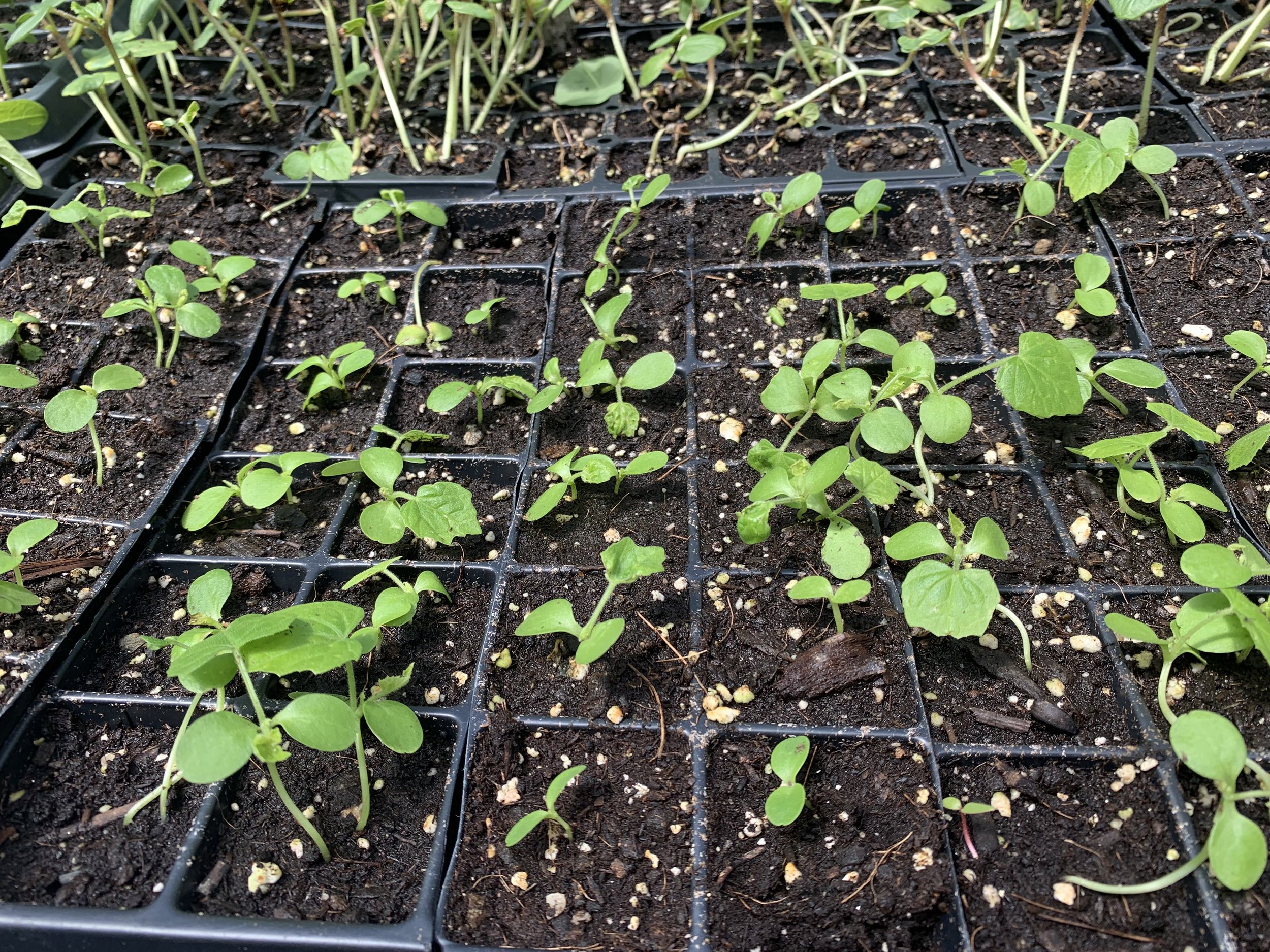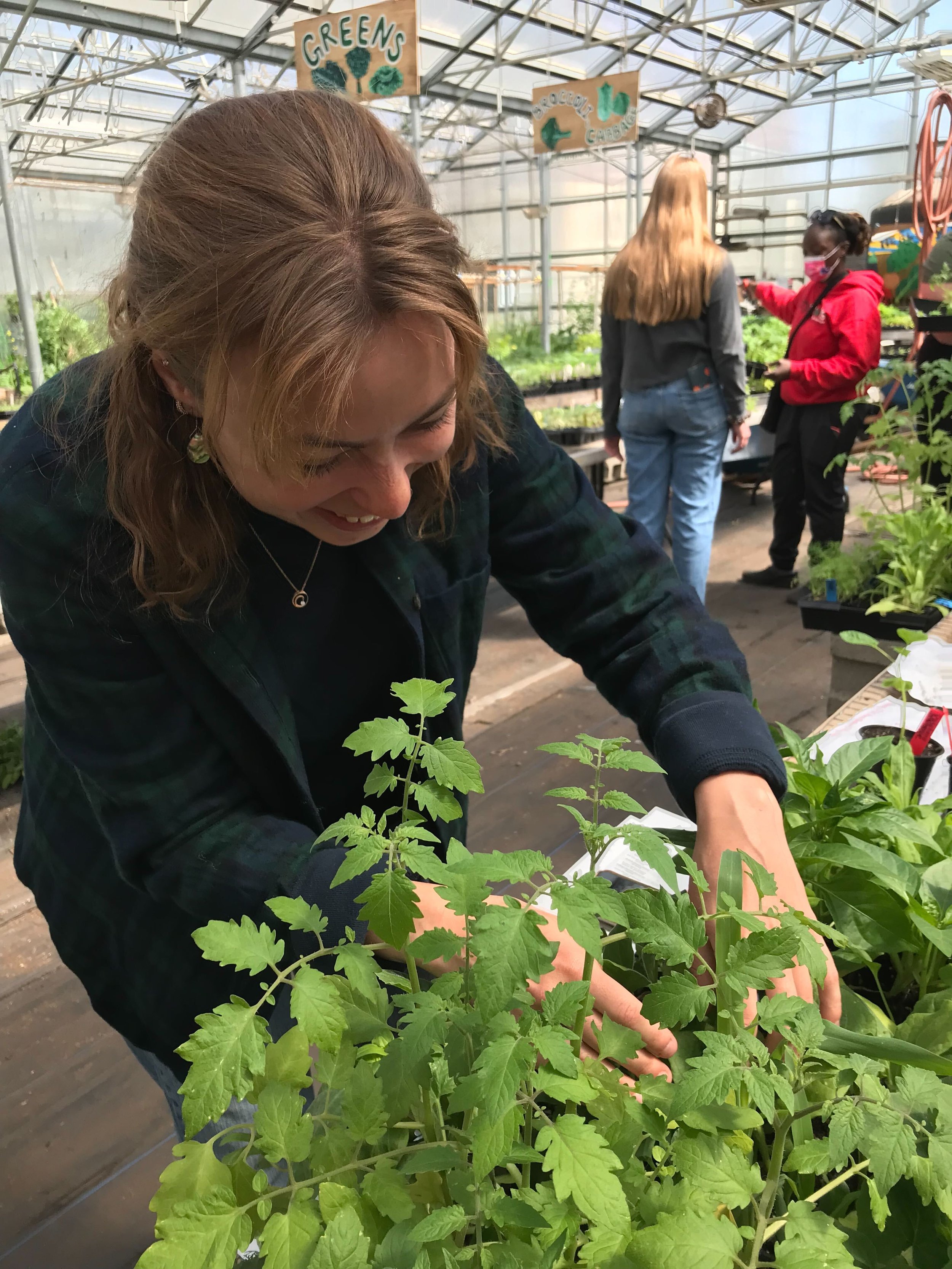The Sprouting of Seedlings and Spring
Krity Gurung, Development & Communications Coordinator
Maggie Eid, Community Engagement Coordinator
Now that spring is in full bloom, our gardens are revitalized. The warmer temperatures and additional hours of sunlight mark the start of the growing season – the time when our plants can develop and thrive. Although the cold winter months kept our outdoor spaces bare, we have been busy growing indoors in preparation for the spring. Over the past month, our gardens have transformed into beautiful green spaces, thanks to the work of our Garden Educators and students. The once-empty beds of winter are now teeming with numerous colorful vegetables, herbs, and flowers.
So, where do we start?
Direct seeding
When growing your own plants, seeds can be planted outside or inside. When started outside, seeds are sown into the garden beds; this is called direct seeding. The seeds then germinate and sprout into plants in the garden soil. For optimum seed germination, the soil’s temperature and moisture must be just right. Otherwise, the plant may be weaker or grow slower, making it more susceptible to diseases and pests. Different types of plants germinate at different temperatures. For example, most varieties of lettuce grow best in cool soil and will not germinate when the soil temperature exceeds 75°F. Meanwhile, tomatoes prefer hot soil and grow best at soil temperatures above 80°F. Leafy greens such as lettuce grow quickly; therefore, they are most commonly direct sown. They can be planted in early spring and harvested 4-6 weeks after that.
Assorted seeds ready to be sown
Direct seeded radish
Seedlings sown indoors at the CitySprouts office using artificial lights
Seedlings
To increase harvest, some plants are more successful when started inside. For example, plants with a long growing season, including tomatoes, peppers, eggplant, melons, and squash require warmer soil and cannot be planted outside until later in the spring. This delay in planting delays harvesting, resulting in a smaller harvest. Since their growing season will be cut short by the fall’s cold temperature, the plants do not have as much time to mature. To avoid this, their seeds are started inside in a warmer climate. Thanks to our partner and friends over at The Food Project, we are able to utilize their Dudley Greenhouse to start our seedlings in an incredible space that is full of light, moisture, and warmth. This year, we began our tomato seedlings on March 18th at the Dudley Greenhouse, a full two months before the temperature was warm enough for them to be planted in the gardens. Inside, the seeds germinate in small containers rather than a garden bed while developing into young plants, known as seedlings. Once the soil and air temperature are warm enough, the seedlings are then ready to be transferred into their outdoor homes for more room to grow and develop into healthy plants with strong roots.
The Dudley Greenhouse located in Roxbury
Baby seedlings at the Dudley Greenhouse
Mature seedlings at the Dudley Greenhouse
What is germination?
When growing your own vegetables from seeds, germination is a very important part of the growing process. Germination is the period in which a seed sprouts into a seedling with the help of water, warmth, light, and the passage of time. During this window, it’s important to tend to your seeded soil, whether direct seeded or from a seedling, with extra TLC. When growing your own food and hoping for a (big) harvest, water, soil, and warmth are the key ingredients to a healthy garden. However, it’s easy to forget that timing is everything. The germination period varies for different plants. While some may take up to two months to germinate, others can take less than 2 weeks to develop into seedlings. Another important consideration is the timing of direct seeding and transferring the seedlings into the garden beds. Pay attention to the soil, air temperature, and the date of the last frost to ensure that your plants have optimal growing conditions.
A CitySprouts outdoor lesson at the Nathan Hale School in Roxbury
Cucamelon seedlings at week 4
Okra seedlings at week 4
Basil seedlings at week 6 (ready to be transferred)
Transferring seedlings
When transferring seedlings, it’s crucial to work with gentle hands. Gently removing the block of soil with the seedling and placing it onto the bigger plot will ensure the seedling and roots have little to no impact. After placing it in the garden bed, surround the seedling with soil and water thoroughly. Some growing plants will be ready to harvest in just a few weeks after they are transferred, while you will have to wait a few extra months to harvest other fruits and veggies. The same practice of working with gentle hands applies to direct seeding as well. No matter what method you’re using, tending to your plants and gardens with love and care is always the most important advice that we have for our young gardeners.
Swiss chard seedlings
Garden Educator Morgan transferring a tomato seedling into a CitySprouts pot
Garden Educator Catherine picking out seedlings at the Dudley Greenhouse to sow into her school gardens
A variety of greens grown at the Dudley Greenhouse
The best part: harvesting!
With hard work, consistency, and patience comes good food! After months of sowing, watering, weeding, and watching, the most exciting part for us and our students is collecting the colorful goodies we grew. Mid-summer/early fall is when our warm-weather plants are fully mature and ready to harvest. Our CitySprouts garden beds are all hand picked by our Garden Educators, students, and volunteers with careful instructions. It’s a common misconception that harvesting always marks the end of a plant’s life. We’re here to tell you that is not entirely true. For plants to grow, they need to be trimmed and harvested when it’s time! Proper trimming and harvesting allows for healthy growth and strong roots. It also encourages the plant to produce more faster. So, if you see a perfectly ripe tomato sitting on a garden bed attached to its stem, it’s time to make salsa!
Student harvesting swiss chard from a CitySprouts garden
Students harvesting beans from a CitySprouts garden
We want to shine light on our partner, The Food Project where we grow all of our amazing seedlings. If you’re in the Roxbury area, please be sure to give them a visit at the Dudley Greenhouse. And if you’re looking to purchase healthy seedlings and support a local business, please pay Bonny’s Garden Center a visit in Cambridge.
Resources:
The Vegetable Gardner’s Bible, 2nd Edition by Edward C. Smith
We Garden Together! By Jane Hirschi and CitySprouts Educators
As always, follow us on Facebook, LinkedIn, and Instagram to stay up to date with all things CitySprouts!

















